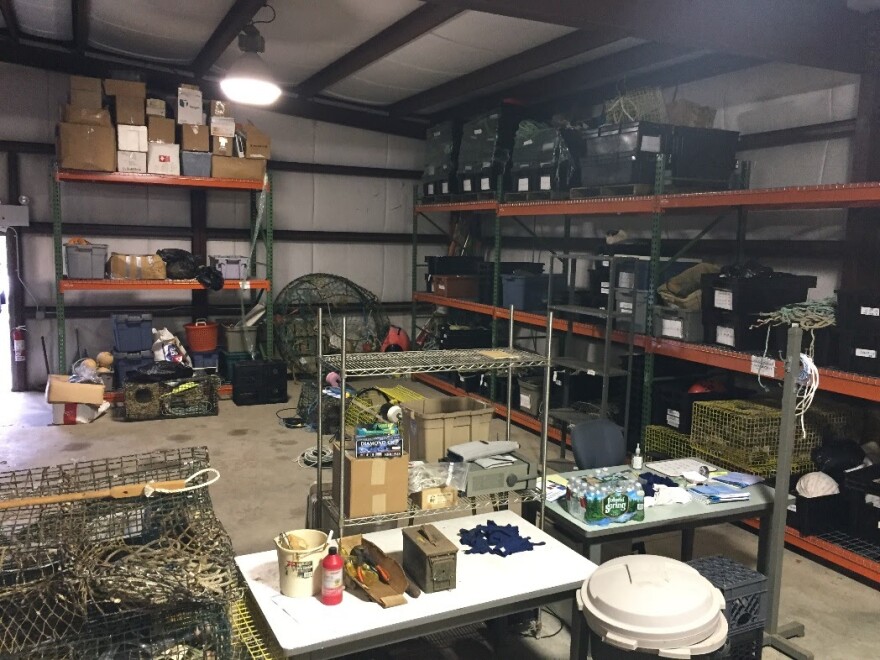Conservationists say that every North Atlantic right whale counts, as the population has fallen to around 360. But one entangled right whale found in Cape Cod Bay—named Snow Cone—has triggered an outcry of frustration from fishermen, who say they’re being unfairly blamed for the decline of the critically endangered species.
The uproar started with a Facebook post.
On Wednesday, March 10, a team from Provincetown’s Center for Coastal Studies freed Snow Cone from 300 feet of rope. Though some rope remained, possibly embedded in her jaw, the team felt they gave her a fighting chance to shed the rest on her own.
“We’re going to keep an eye on her, and help her out if she needs more,” said Scott Landry, who oversees disentanglement efforts. “We think we did our best by her.”
Shortly after, the center described the team’s success on its Facebook page, and used a photo from an aerial survey that shows the whale and the telltale rope from 1,000 feet in the air.
“So, I remember seeing this,” said Nick Muto, who’s been catching lobsters out of Chatham for the last 20 years. “They posted something, you know: 'Right whale number 3560; Snow Cone; 16-year-old breeding female; partially disentangled.'”
Right away, Muto noticed that the Facebook post said the retrieved rope likely came from a fishery, but there was no close-up picture.
“So my hashtag, #ShowUsTheRope, is me trying to lay it right on the Center for Coastal Studies,” he said. “I’m saying, ‘Hey, involve us in the process. Show us the rope. Let us weigh in on what's going on.’”
Nearly 85 percent of right whales bear scars of entanglement. But some fishermen say they’re being cast as villains, as little is publicly known about the specific rope being pulled off of whales. Fishermen say the color, diameter, and specific markings on rope or buoys can act almost like fingerprints to identify the source either geographically, or in some cases, down to an individual fisherman.
“There's fishing gear up and down the coast. Some of it can be towline; some of it can be discarded line; some of it can be from the recreational sector,” Muto said. “It's just automatically labeled as fishing gear and we're the ones that pay the price.”
The center did make clear: the rope in this case probably didn’t come from Cape Cod Bay, because Snow Cone’s injuries look months old, and right whales haven’t been in local waters that long.
Also, the rescue group isn’t collecting evidence. That job belongs to federal analysts and law enforcement groups, who have to be able to study the gear first before releasing photos.
“Law enforcement will open up an investigation into it. Until the investigation is closed, we don't release a lot of information,” said Colleen Coogan, a wildlife protection official for the National Oceanic and Atmospheric Administration (NOAA).

Law enforcement teams and gear analysts, including several fishermen, examine retrieved gear in a warehouse in Rhode Island, where members of the public can request a tour, she said. Those tours have been canceled in the last year because of COVID-19 restrictions.
But fishermen say the whole process is flawed: pictures of the gear aren’t posted online. Rather, the federal fisheries service produces a report that includes descriptions of gear, without any photos. And the reports come out so infrequently that the last one is four years old.
"Hmm... that’s a little stalled,” Jeffery Richardson, a lobsterman based out of Sandwich, observed of that four-year lag. He was only half joking. “I want to see proof,” he said.
The near impossibility of seeing this proof is especially frustrating, he said, because the stakes are growing more dire. To protect the whales, Massachusetts regulators have required the state’s 800 lobstermen to use special rope that breaks more easily under pressure from whales, and they’ve closed the lobster fishery in nearly all state waters from February to May.
Fishermen, who describe a deeply mistrustful relationship with conservation groups and federal officials, want to know how the regulations are justified by the evidence.
“That is the million-dollar question,” Coogan said. “So we're authorizing a fishery that we cannot state with confidence is not contributing to the serious injuries and mortalities, and we're not allowed to do that. That’s what the laws say.”
Ninety-three percent of ropes that run from surface to seafloor in Northeast waters—the ones that are most likely to entangle whales—come from the lobster and Jonah crab fisheries, Coogan added. And if officials wait to know for sure that these fishermen’s gear is to blame for the majority of entanglements, the already dwindling population will just continue to decline.
“We don't have the time to wait till we have all the data,” Coogan said.
For their part, many fishermen say they understand that the whales need to be protected, but they don’t feel like they should be expected to take everything on faith. They said they’re being regulated nearly out of existence, and can’t even see photos that might prove they’re to blame.
It only leaves Richardson with less trust, and more questions.
“Why,” Richardson asked, “why, why wouldn’t you want to try and prove your point? You say it's a fishing rope, but you're not going to show us any pictures of what you found?”
To put it simply, the fishermen say: “Show us the rope.”








